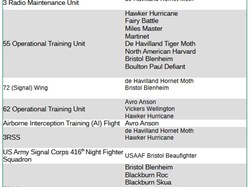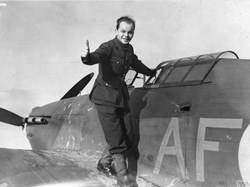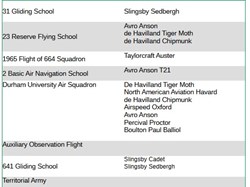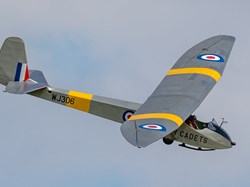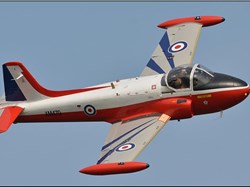RAF Usworth Pt 2 to 1962
World War Two
Part 1 of this history charts the development of Usworth Airfield from it's origins in World War One up to the outbreak of World War 2 in 1939.This part summarise what happened at the airfield during the War and it's remaining years as military base
Click here if you prefer a pdf version of the complete story, but note that images cannot be enlarged.
Not surprisingly World War Two were the busiest years in the military life of the airfield. It took the physical form that survived until 1984, and thousands of servicemen past through the facility.
Development of the airfield began in the month war started (September 1939) when work started on the construction of two concrete runways, one of 2,800 feet laid north west to south east, with another of similar length on a north-south heading. At the same time the airfield was extended to the south, east and west, taking in adjoining fields, to occupy about 225 acres. A new perimeter track was laid along the airfield boundary with eight dispersal points and hard-standing areas.
Many additional buildings were built along with an Operations Room, later supplemented by an underground Battle HQ near the Cow Stand Farm corner of the airfield, plus a new radio station. On the North Camp side of the road new accommodation blocks were constructed. On both camps numerous air raid shelters were built.
A series of dispersal sites off the airfield were also constructed, including a searchlight camp at the top of Ferryboat Lane. Anti-Aircraft gun posts were set up on the Birtley Road at the bottom of Boldon Bank and along a disused railway line towards north Hylton. A large gun site was set up near Downhill Farm, and a new decontamination centre was built on the Birtley Road. Most of these sites would be manned by members of the Durham Light Infantry and the Royal Artillery.
Table 3 shows the mix of air force and other military units stationed at Usworth at one time or other and the variety of aircraft- mainly trainers- that used the airfield, quite often for very short periods.
The most intense years were 1940 to 1943. The most significant action involving Usworth aircraft took place on 15 August 1940. Usworth was one of many targets for a large German raid, that was driven off, with large causalities, without reaching the airfield.
See Wartime & Military -607 Squadron, RAF Usworth for a detailed account of this action.
The only other hostile actions were high explosive bombs landing near the airfield in April 1942, and one that hit the runway in March 1943 that didn’t explode.
Pilots of many nations were trained at Usworth, including Polish, Czech, Canadian, Australian, American, New Zealanders and smaller numbers from Latvia, Lithuania and Ceylon. Training was dangerous and many aircraft were damaged or destroyed during training, killing 55 aircrew, 32 in 1941 alone- see the attached table for a list of known RAF Usworth fatalities in World war Two. The greatest loss of life was when two Ansons collided over Boldon in 1943, killing all 9 servicemen. Many of these are buried in Castletown Cemetery, near the airfield, where ten of their German enemies are also interred. Another serviceman was killed during a bombing raid at nearby Whitburn.
Click here to read the extraordinary story of Augustin Preucil, the Gestapo Spy of Usworth.
A companion article (Washington in World War 2) includes some of the mishaps by Usworth-based aircraft, up to February 1942.
Apart from occasional visiting aircraft most flying from 1944 onwards was training by the Gliding School, a role that continued until 1958.
(Click on the images below to enlarge them)
he most intense years were 1940 to 1943. The most significant action involving Usworth aircraft took place on 15 August 1940. Usworth was one of many targets for a large German raid, that was driven off, with large causalities, without reaching the airfield.
See Wartime & Military -607 Squadron, RAF Usworth for a detailed account of this action.
The only other hostile actions were high explosive bombs landing near the airfield in April 1942, and one that hit the runway in March 1943 that didn’t explode.
Pilots of many nations were trained at Usworth, including Polish, Czech, Canadian, Australian, American, New Zealanders and smaller numbers from Latvia, Lithuania and Ceylon. Training was dangerous and many aircraft were damaged or destroyed during training, killing 55 aircrew, 32 in 1941 alone- see the attached table of known RAF casualties during World War Two. The greatest loss of life was when two Ansons collided over Boldon in 1943, killing all 9 servicemen. Many of these are buried in Castletown Cemetery, near the airfield, where ten of their German enemies are also interred. Another serviceman was killed during a bombing raid at nearby Whitburn.
(Click on the photographs below to enlarge them)
A companion article (Washington in World War 2) includes some of the mishaps by Usworth-based aircraft, up to February 1942.
Apart from occasional visiting aircraft most flying from 1944 onwards was training by the Gliding School, a role that continued until 1958.
The Post War Years
Powered flying returned to Usworth on 1 February 1949 when 23 Reserve Flying School was formed, and later the Durham University Air Squadron moved to Usworth. In 1951 control of Usworth past to 2 Basic Air Navigation School.
Table 4 shows the mix of units, training aircraft and gliders that used Usworth up to 1962.
The airfield was now back to operating 7 days a week. The student navigators were all RAF (mainly on National Service), though the pilots were RAF Volunteer Reserve, all ex-RAF pilots and navigators. Airwork Ltd had a contract to run the school, employing civilians to do aircraft maintenance and overhauls. Most of the fitters were ex-RAF.
After these units departed the last military use was by the Territorial Army for parachute training from tethered balloons.
(Click on the photographs below to enlarge them)
On 3 July 1962 RAF Usworth was purchased by Sunderland Borough Council for £27,000 and was reopened as Sunderland Airport. The long life of RAF Usworth had come to an end.
It became England’s smallest municipal airport, though it never had any scheduled passenger services. Business use was a small amounts of freight and corporate light aircraft. It was used by the Royal Flight and a base for military parachuting display teams. Its greatest use was by private pilots of light aircraft and microlights, and skydivers. In May 1974 the North East Air Museum opened- now The North East Land Sea & Air Museum (NELSAM).
In January 1983 the largest RAF aircraft even to land at Usworth, the B2 XL319 Avro Vulcan bomber, arrived, and is now on NESLAM’s site, which was relocated to what had the North Camp.
There are no records of the myriad of aircraft based there, or called in, or those who made the occasional emergency landing. The clubs based there organised Air Days from 1966 to 1983. However it was offered to Nissan Manufacturing in March 1981 for their UK manufacturing site, which they chose in March 1984.
The last flights took place on 31 May 1984. A Jet Provost flypast acknowledged the history of one of the RAF’s oldest airfields.
(Click on the photographs below to enlarge them)
Contact Washington History via washingtonhistorysoc@gmail.com if you know more about Usworth airfield before and after World War Two

